How the 1955–57 “Tri-Five” Chevy became a midcentury masterpiece
As companions to Aaron’s lovely historical feature below, we are publishing three Hagerty member stories about their own Tri-Fives. You can read the first installment, about a green 1955 Nomad ex-drag car, here. The second installment, about a 1957 Bel Air convertible dream car, lives here. And lastly, our final installment about Betsy, a tattoo artist’s 1956 Chevy Bel Air Sport Sedan, here. –EW
It’s strange to start a story about some of the greatest General Motors cars ever produced with a nod to Henry Ford. But that’s where it begins, with the famous founder’s resignation in 1945 and the handing of the company keys to his 28-year-old grandson, Henry Ford II. From his perch atop his mighty arsenal of American industry, the young Deuce could see an even taller mountain just to the east, and it had a chrome bowtie on it. Ford knew what he had to do. “Here’s the car that will lead the way,” ran a subsequent Ford advertising ditty, “and beat the hell out of Chevrolet.”
Well, there were 90,000 people working for Chevrolet in the early 1950s, headed by the likes of general manager Thomas H. Keating and chief engineer Ed Cole. They weren’t going to simply roll over while Ford ate their lunch. Competition spurs innovation, and when the wraps came off the 1955 Chevrolets, the Deuce must have known that he was in a fight. Chevy showed that it was quitting the business of selling plump little economy sedans for the old folks. The ’55s were trim and direct, with a Ferrari-inspired grille, a Corvette-influenced dash, a rakish two-tone color scheme, and a new V-8 if you wanted it. The chrome and other tick-tackery were kept to a minimum—the jet taking flight on the hood notwithstanding—and the car’s bluff body lines were left to stand on their own.
Somehow, in one car, Chevy captured the boundless optimism of a nation whose youthful population was growing by 11,000 souls a day while also embodying John Wayne’s maxim to “talk low, talk slow, and don’t say too much.” The rest, as they say, is history. The 1955, 1956, and 1957 Chevys sold in the millions and became the holy Tri-Five, the beloved Shoebox Chevys (because of their boxy profile), the three cars that for a graying generation today best represent the decade of the 1950s and all their fond memories of youth, freedom, rock-and-roll, horsepower, and a prosperous suburban America at peace.
For the rest of us, the Tri-Fives, a nickname invented in later years to encompass the ’55s, ’56es, and ’57s, are simply cool, sized and styled just right and in a way that transcended the era of excess into which they were born. Today, a ’55 Plymouth is delightful; a ’55 Chevy is a national monument. Drive one through Brooklyn, Highland Park, North Kansas City, or Compton and people will flash you a thumbs up. Ford sure tried, but it couldn’t bump off the bowtie as the most American of American brands.
The Tri-Five’s genesis started when Ed Cole kicked the door in at the sleepy Chevrolet Division in May 1952. Demanding and energetic, Cole had led the development of the 1949 overhead-valve V-8 at Cadillac before going off to a GM defense plant in Cleveland to run tank production for the duration of the Korean War. He arrived at Chevrolet already determined to invigorate its fusty image, with the Corvette planned for 1953 and a cut-price V-8 coming to finally answer Ford’s decadelong lead in that department. Chevy wanted younger buyers, and the youth wanted horsepower. GM had earmarked $300 million for Chevy’s 1955 model overhaul, and Cole was determined to spend all of it.
He went on a recruitment drive, luring young engineers with the tantalizing prospect of reinventing Chevrolet with bold, exuberant products aimed at performance. Then he flushed whatever the division had already been working on, shelving a V-8 project based on the expensive and heavy Cadillac motor and tasking his staff with developing an engine that was smaller, lighter, cheaper to make, but still powerful. Precision thin-wall casting and stamped rocker arms were some of the enabling technologies for a compact new 265-cubic-inch “small-block” V-8 that would launch a dynasty, the descendants of which are still in production today.
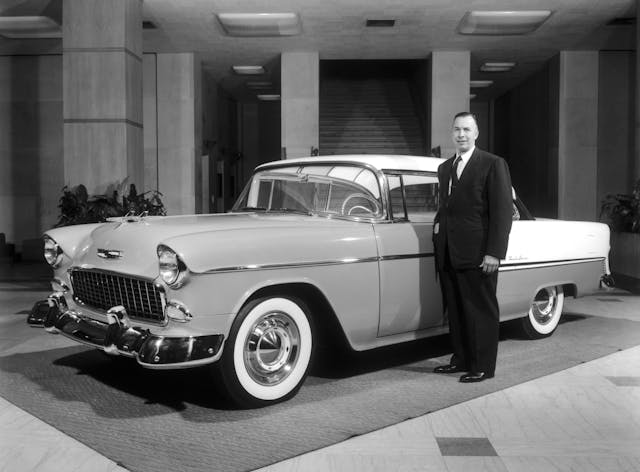
Wisely, Cole nurtured his relationship with GM’s autocratic styling chief, Harley Earl. Thus, unlike other divisional chief engineers, he was not an unwelcome visitor to the styling studio on West Milwaukee Avenue, behind the GM headquarters building in Detroit. There, through the summer of 1952 and into 1953, the ’55 Chevys emerged from sketches and clay lumps under the guidance of the division’s styling head, Clare “Mac” MacKichan.
“We were working on front ends in the studio in the early stages, and one day Harley came in and said, ‘You know, I saw a Ferrari, and I’d like to try that kind of grille on the car,’” MacKichan recalled to author Michael Lamm in 1975 for Lamm’s subsequent book, Chevrolet 1955: Creating the Original. “And then he described what he wanted and, of course, we got out magazines and pictures and started to do this grille.”
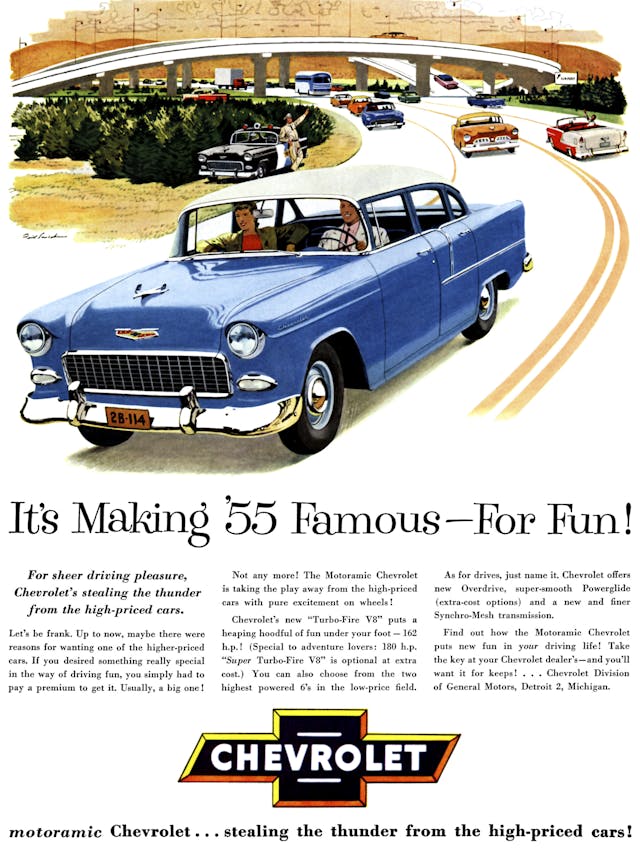
On Milwaukee Avenue, they were aiming high, trying to produce a mini-Cadillac at a Chevrolet price. Hooded headlights and frenched-in taillights that recalled a lady’s elegantly enameled fingernail were prominent Cadillac riffs. As a flourish and to accentuate the rear haunches, the designers pressed a dip into the horizontal beltline just aft of the B-pillar and accented it with a chrome band that joined to a side spear. These ornaments formed a natural border for one of the ’55’s signature elements, a white accent color on the top trim level that wrapped over the trunk and onto the opposite quarter panel.
“The Hot One,” as Chevy marketers called it, debuted officially when dealers peeled the paper off their showroom windows on Thursday, October 28, 1954. The public pressed in to see the new car—and it was indeed totally new. Of the roughly 4500 parts that went into a 1955 Chevrolet, boasted Keating, Chevy’s general manager, fewer than 700 were carryover from the previous year. Including the switch to a 12-volt electrical system, the changes, crowed the former car salesman with perhaps understandable hyperbole, “were greater than have ever been attempted by an automobile manufacturer in one year.”
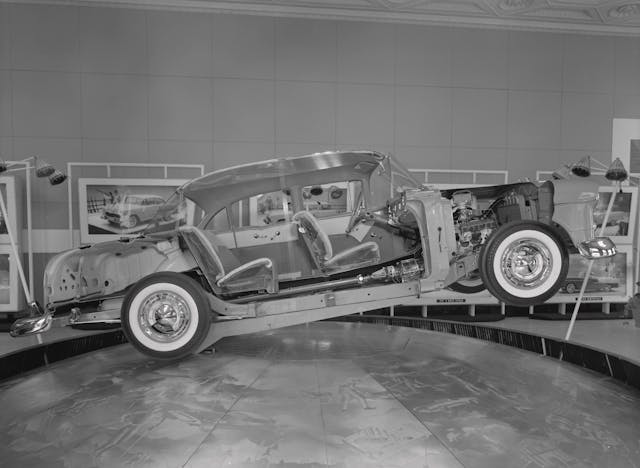
The new 162-hp Turbo-Fire V-8—or 180-hp with the optional four-barrel carb and dual-exhaust “power pack”—was said to benefit from “dynamic engine balancing” that involved spinning each engine to 700 rpm and using an “electronic brain” to measure and counterweight out any wiggle in the crankshaft. Other robotic machines were used to perfectly broach, plane, and mill the 190-pound castings of the V-8 block. For the first time, overdrive was an option on a Chevy, though priced at a steep $108.
There were three models—the base 150, the mid-priced 210, and the deluxe Bel Air—encompassing 16 separate body styles. Earl wanted to offer something special for the ’55 Chevys, so in 1953, he commanded his team to sketch a two-door wagon that used the upper half of the forthcoming 1954 Corvette Nomad show car and the bottom half of the ’55 lineup. Station wagons were red-hot sellers at the height of the baby boom, by which time 35 million Americans were said to have moved out to the suburbs. The Chevrolet Division built 160,000 wagons in 1955, the Nomad (as well as the lesser 150 and 210 versions, which weren’t called Nomads) being one of two wagon bodies offered that year. The two-door wagon claimed a healthy 54,000 sales in ’55.
However, sales were halting at first; the public took time to warm up to Chevy’s pivot. During the first two weeks, weeds grew at the dealerships, and GM president Harlow Curtice called a meeting of Keating, Cole, and other managers. Curtice arbitrarily pinned the problem on the grille, saying that Ferraris sold in the hundreds while Chevy was gunning for millions. The group sketched out a rush program to redesign the grille, but before it could be implemented, dealers began to see some traffic (the replacement grille concept was adopted on the ’56 models).

Perennial Chevrolet pitchwoman Dinah Shore rode the back of a Bel Air convertible to pace the 1955 Indy 500, while drivers Fonty Flock and Dave Hirschfield campaigned the new car in NASCAR’s various series. Kustom king George Barris wasted no time applying his touch, restyling a ’55 Chevy with Dodge trim pieces, Lincoln taillights, and a Corvette grille. Said Chevy designer Dave Holls: “If there was ever a time when the kids went 360 degrees from Fords to Chevys, it was 1955.”
By the spring of 1955, the cars were flying off lots. On April 28, a Thursday, the Chevrolet Division set a one-day industry production record, cranking out 7902 cars and 2178 trucks before the evening whistle. In announcing the record, Keating reeled off some statistics: the $20 million worth of vehicles produced by Chevy in one day would, if parked end to end, stretch 35 miles. The 33 million pounds of steel needed to make those vehicles had employed 20,000 steelworkers and was enough metal to erect a skyscraper with a base of one whole city block and a height of 25 stories. Altogether, Chevy’s plants and their suppliers had consumed 50,400 tires on that Thursday, 1.7 million pounds of paint and other chemicals, 7 million pounds of iron, 27 million gallons of water, and 650 tons of coal, while producing enough textiles to wrap around the globe four times.
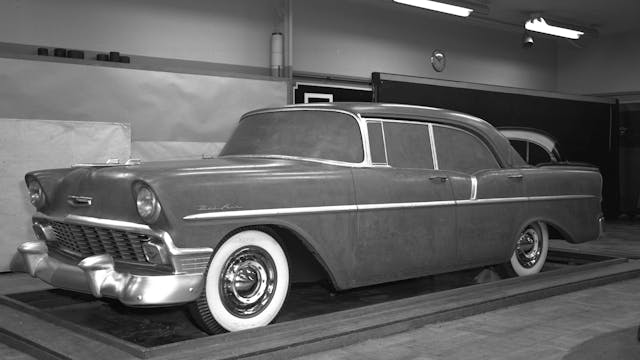
Such was the postwar industrial colossus that was Detroit, the city’s Big Three (GM, Ford, and Chrysler) owned 95 percent of the U.S. auto market in 1955. Chevrolet handily beat Ford that year, as it did in 1956 when it softened the car’s look slightly and applied the ’55’s wider replacement grille. Always a fan of chrome, Earl pressed his underlings to gussy up the now spectacularly successful Chevy line for 1957. The result was an even larger and busier oval grille bracketed by prominent bullets and bisected by a chrome center bar housing inset parking lights. The flat hood sprouted two long bulges capped by chrome rockets jutting forward, and the treatments got more deluxe as buyers moved up the line. Flashy dorsal-shaped side molding inserts for Bel Airs accentuated the new tailfins.
Though it’s revered today, the ’57s proved less popular with the public then, and Ford regained the sales crown by about 30,000 registrations. Some economists blamed the fierce battle between Chevy and Ford, with all the attendant discounts, rebates, and overproduction, for sparking the 1958 recession. It was said that pie-in-the-sky sales targets involved shoving cars on to people who couldn’t afford them (auto loan defaults climbed dramatically in 1958) while driving the few remaining independents, Nash-Hudson, Studebaker, and Packard, to the brink of bankruptcy.
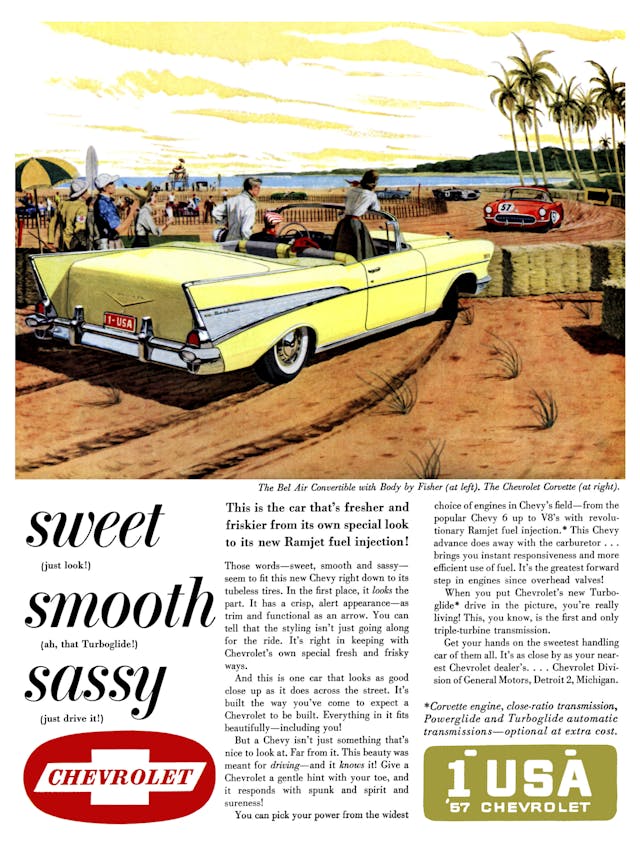
Whether true or not, Ford and Chevy continued their sales war, the latter largely abandoning vertical tailfins after ’57, flopping them over into horizontal blades before pruning them off entirely for 1961. The completely redesigned ’58 Chevys followed the industry trend toward longer and wider cars with even more chrome, and the all-too-brief Tri-Five era was over.
Except that it wasn’t. The Chevys from those three years took less time than most models to rebound from depreciating used cars into desirable classics. There’s always been something appealing about a big engine dropped into a cheap car, and the ’55 Chevy with its compact new V-8 was destined to rank with the ’32 Ford as the roots of America’s muscle car epoch.
GM turned against racing, starting with a 1957 ban by the Automobile Manufacturers Association and reinforced in 1963 by a company fearful of breakup by antitrust crusaders. That meant the Tri-Fives would represent at the drag strips in later years as the car of the grassroots independents and the little guy. Into the mid-’60s, small-block tuning pioneers such as Bill “Grumpy” Jenkins and his Monster Mash ’55 Chevy were cheered as underdogs against the newer factory jobs. Meanwhile, the Chevy Nomad seemed built to specification for the 1960s surf craze set to an epic soundtrack by The Beach Boys, Jan and Dean, and Dick Dale & His Del-Tones.
Early on the Tri-Five was a screen regular, starting with Rebel Without a Cause and the Highway Patrol TV show. Star turns in Two-Lane Blacktop (1971), American Graffiti (1973), and Diner (1982) kept the Tri-Fives in the public’s eye as the most 1950s of 1950s Americana. Go online today and you can buy Tri-Five metal signs, Tri-Five models, Tri-Five T-shirts, Tri-Five–only magazines, and couches made to look like the rear end of a Tri-Five Chevy. Those three model years support an enormous aftermarket parts industry that supplies everything to keep a Shoebox Chevy running, up to and including completely new steel body shells officially licensed by Chevrolet.

Which is why if you go to any car show, concours, cars and coffee, or cruise-in anywhere in America (and likely elsewhere), you’re all but certain to see at least one 1955–1957 Chevrolet. More than 3000 show up every year to the Tri-Five Nationals hosted by the American Tri-Five Association, whose members are certain to write in and point out with exhaustive detail any mistakes in this story.
A story which, at its heart, is about a commercial product. It was developed and built for the purposes of turning a profit over three short fiscal years in the life of a corporation that, once those years were over, quickly moved on to other matters. Car designers and engineers usually don’t know when they’re being timeless—not until some time has passed. They also don’t get to pick which of their creations qualifies; that’s for the rest of us to decide. And in the intervening years, the masses have spoken, blessing the Tri-Five with its well-earned immortality.
This article first appeared in Hagerty Drivers Club magazine. Click here to subscribe and join the club.
Check out the Hagerty Media homepage so you don’t miss a single story, or better yet, bookmark it.



What is Ironic is the impact of the Tri Fives was not really felt till after they left production. Keep in mind the 57 Ford out sold the 55 Chevy. The 58 most snubbed.
But the things started with The V8 resonated in the coming cars in the 60’s and retro brought the 55 back as the used car you could easily modify and race.
Too much history in hindsight is not always as it really was. The Tri Five cars were not legends till later and it was the hot rod community and racing that really crowned the car as a legend.
As for the nose. Harley saw the Ferrari at the Paris Auto Show. He was intrigued with the egg crate grill and the head lamps. Once he came back he ordered them to try them on the car. He had openly admitted he stole them from Ferrari.
In ’58, my parents bought a ’57 Chev 210 wagon. Copper & cream, 283 / power glide. A neighbor had a ’56 Bel Aire 4d pillarless, dark green & white. My first car was a ’55 210 sedan, 6 – 3 on the tree.
I’ve always liked the looks of the ’56 better than the other 2.
I know I’m in the minority, but I’ve never seen the huge appeal of the Tri-5. I don’t DISlike it, especially the 56, but it’s just not all that. It’s window dressing on a really plain, tall, boring, boxy car. By contrast the “Forward Look” cars over at Chrysler, Plymouth, Dodge, and DeSoto were actually revolutionary. Lower, sleeker, more modern, better proportioned (especially DeSoto and Chrysler). Within GM, olds and Buick were better looking, to my eye. But to each his own… I’ll still stop and admire a nicely restored Tri-5, but it looks like it’s still a product of the post-war 40s more than the 50s.
Good points, I agree with you
I agree with that. It was probably the best iteration of the slab sided car of that period. The Chrysler range of 57 totally changed the game. So in period the Chevs looked suddenly old. But history is constantly revised and the 57 Chev is a staple of movies and tv shows which aren’t bound by reality. For them it is shorthand for the 50’s. Much in the same way an early Mustang is by law required in each movie to denote the early-mid 60’s.
In 1962 I obtained a ’56 Bel Air 2 door sport coupe. Black and White, 265 V8 Power Pack, 3 speed manual with Overdrive and standard 4.10 rear axle. Quite the vehicle and what a great powertrain. At the time I was a student at General Motors Institute in Flint, Michigan and working at the Chevrolet Product Engineering Dept. at the Tonawanda, New York engine plant. Living the Dream !
We have 2 1955 Chevy’s, a 210 and a 4 door belair, which is mine. My husband wants to make it 3 and add a pickup truck. I love them both and they are insured with the best company on the planet—–HAGERTY…
I have a 57 Chevy 210 2 door hardtop and a 1958 Apache pickup, go get that truck and add to your collection.
I got my license in a ’57 210 2dr hardtop (6cyl, auto), and later owned a 210 4dr hardtop (v8, auto). Neat cars, low production, seldom seen now. I just found a 1/18 twin of the 2dr, now I have an itch to get a real one, but I don’t know how to explain that to all the Olds wagons currently filling the parking spaces.
Superb shirts w/ frontal view of ‘red 57 Chevy available in black, white, long or short sleeves at motorlegends.com
Thanks for a nice article on the iconic “shoe box” Chevrolets. I’ve owned a few and even saw a large part of “Dinah Shore’s USA” while traveling to CCI and National Nomad Conventions. Those cars will always be a crowning achievement of 1950s American cars!
I agree and I am a 55 Chevy Belair owner. 1957 Plymouth Fury. White with gold color accents on the grill, sides etc. 1955, 56 Desoto’s. Forward looking body and some wild paint schemes. 1957 Dodge another sleek car. 1957 Chrysler 300C. That was a good looking land cruiser. Finally, the 1955 Imperial with those taillights on top and recessed on the fenders.
My mother bought a 57 that I got to drive all threw high-school. 4 door Bel Aire. Sierra Gold and pearl white. I later found the exact car in Lyons Kansas with a bad transmission which I bought for fifty dollars. My ex wife’s brother repaired the transmission and several more brothers drove it to Montana. Thank you Kennedys. Still have it and a 57 parts car. I am so lucky.
When I was 12 or so in 1964 hanging out at a small WV river town gas station, a 57 Chevy Turquoise & White went by & we all stared at it driving by one of the mechanics said one day that we would be able to buy anything that we needed for a 57 Chevy. Man was he ever right!
When the ’57 Chevy was introduced, I thought it was a copy of the ’56 Studebaker.
Good point. The 57 Plymouth Fury also magically somehow looks similar too. It seems like cars have always been more similar than distinctive. Until Tesla came along anyway.
I would love to see someone remake these vehicles with a modern Engine System and features. The sales would be as dynamic as they were in the 50’s. Are you listening Elon?
You can buy a complete new trifive. Frame, body, drive train, interior with modern accessories.
All you need is $$$$$$$. Money can buy anything. Ask a politician.
People do it all the time, LS engines and electronic automatic overdrives, A/C full power etc.
They do you can get a brand new one now all new steal body up to date chassis ls engine and brand new old car
I like them but at the same time they sort of bore me when I see a dozen of them in a row.
Jim Stark’s car in Rebel Without A Cause was a 1949 Mercury two-door sedan, not a Chevrolet.
And the Highway Patrol series never used a Chevy.
I agree, Crawford drove a Oldsmobile!
Correcto Mundo! Buicks riled sometimes a Merc. snuck in.
Spin testing the short blocks and setting the vibration parameters for various performance levels was imported from Germany by Zora! Great car better motor made for great sales…PS Always appreciate H V6 comments -thanks!